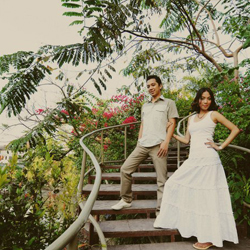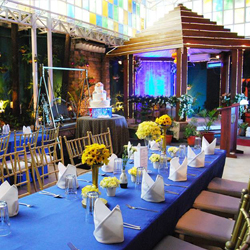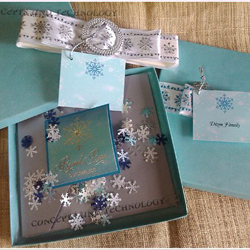Zamboanga del Sur – Fusion of Diverse Cultures
Zamboanga del Sur, one of the province in the Zamboanga Peninsula, is perhaps the best example on how diverse cultures have seemingly fused together in one place. The culture of the Subanons, the first inhabitants of the province, and Spaniards are well reflected in their ways and celebrations.
This fusion is very evident in the tourist attractions of the province; from Spanish-era forts to cultural villages showcasing indigenous arts and crafts, Zamboanga del Sur has a lot to offer to anyone seeking to know more about the rich culture of the Philippines.
Demographics
1. Population –
1,688,685 (as of 2007 Census)
2. Land Area – 5,914.2 sq. km
3. Capital – Zamboanga City
4. Language/Dialect – Cebuano, Chavacano, Subanen,
English, and Filipino
5. Divisions
Cities (2)
- Pagadian City
- Zamboanga City (independent city)
Municipalities (26)
- Aurora
- Bayog
- Dimataling
- Dinas
- Dumalinao
- Dumingag
- Guipos
- Josefina
- Kumalarang
- Labangan
- Lakewood
- Lapuyan
- Mahayag
- Margosatubig
- Midsalip
- Molave
- Pitogo
- Ramon Magsaysay (Liargo)
- San Miguel
- San Pablo
- Sominot (Don Mariano Marcos)
- Tabina
- Tambulig
- Tigbao
- Tukuran
- Vincenzo A. Sagun
Megayon
Festival
It is an institutionalized tri-people festival to showcase
the arts and crafts of Zamboanga del Sur.
Lakewood
This lake intersects the whole town of Lakewood. The
most popular species of fish in the province can only
be caught in the lake: the carpa and porang.
Buklog
One of the religious rituals and ceremonies of the Subanens,
it represents the social hierarchy of the Subanon community.
Cultural
Campo Muslim
- Rio Hondo
Location: Brgy. Rio Hondo, Zamboanga City
Colonies of coastal Tausugs, Samals, and Badjaos live
in frail-looking houses-on-stilts. Inside the compound
is the Campo Muslim, marked by a silver mosque built
on stilts.
Taluksangay
Village
Location: Brgy. Taluksangay, Zamboanga City
It was in this village where the first Islamic culture
was introduced in 1885. It was also here where the first
Islamic Mosque was constructed.
Yakan Weaving
Village
Location: Brgy. Calarian, Zamboanga City
The Yakans, the original inhabitants of Basilan Province,
are considered among the finest weavers in the Philippines.
The Yakan weave is so fine that it takes a week or so
to finish a meter of cloth. The Yakan cloth commands
a high price in well-known trade centers in the Philippines
because of its craftsmanship.
Historical
Fort Pilar
Location: Zamboanga City
It is a 17th century military defence fortress built
by the Spaniards to serve as defense against pirates
and raiders of the sultans of Mindanao and Jolo. Built
in the year 1635, the fort was originally called "Real
Fuerza de San Jose". In 1718, it was rebuit and
renamed "Real Fuerza de Nuestra Señora del
Pilar de Zaragoza" in honor of the patron virgin
of Spain, Our Lady of the Pillar.
Petit Barracks
Location: Zamboanga City
US forces under Gen. C. Bates occupied after the capture
of the city on November 15, 1899. It was named Pettit
Barracks after Col. James S. Pettit, 31st Infantry,
US Volunteer Commanding Officer of the Second Military
District. Occupied by Japanese forces in 1942-1945,
the barracks were recaptured by United States and Philippine
liberation forces on March 10, 1945, and turned over
to the Philippines on July 4, 1946.
Japanese
Memorial Shrines
Location: Pasonanca Park and Brgy. Malagutay, Zamboanga
City
The shrines are made of marble that came from Japan
with names engraved on it in Japanese character. The
names engraved are those of the Japanese soldiers who
died during the World War II as they were retreating
from the liberating US Forces.
Man-made
Aurora Mountain Resort
Location: Brgy Anonang, Aurora, Zamboanga del Sur
It has a wide swimming pool, which is the favorite hunt
of bathers from the nearby eastern municipalities.
Lily’s
Hidden Spring
Location: Brgy Tubod, Lakewood, Zamboanga del Sur
Along the rocky highlands and steep mountainside flows
the lovely Lily’s Hidden Spring with splashing
waters to the delight of nature lovers.
Bagalupa
Hanging Bridge
Location: Brgy. Bagalupa, Labangan, Zamboanga del Sur
Measuring at 80 meters in length, it is built from wooden
floor planks supported by suspended cables.
Lower Sibatang
Hanging Bridge
Location: Brgy. Lower Sibatang, Pagadian City, Zamboanga
del Sur
Measuring at 27 meters in length, it is built from wooden
floor planks supported by suspended cables.
Pasonanca
Park
Location: Brgy. Pasonanca, Zamboanga City
The 58-hectare park has three (3) swimming pools, bordered
by ferns and other greenery. Cool and crystal clear
water flows in and out 24 hours a day from nearby mountains.
The park houses the Zamboanga Convention Center, the
Boy Scout Camp and amphitheatre. Its most popular attraction
is the famous Tree House built in 1960. The stay is
free but only good for a night or two. The unique Tree
House is equipped with facilities for modern living.
It is most ideal for honeymooners.
Cesar C.
Climaco Freedom Park
Location: Sitio Abong-Abong, Brgy. Pasonanca, Zamboanga
City
Some of its popular attractions are a Scout Campsite,
a natural swimming hole called the Chrislam Pool, Heroes
Hill in honor of the World War II soldiers, Freedom's
Eternal Shrine honoring the late Benigno "Ninoy"
S. Aquino, Jr., and Ecumenical Holy Hill where the 14
Stations of the Cross can be found leading to a giant
white cross atop a hill overlooking the city and the
Basilan Strait.
Assemblyman
Joaquin F. Enriquez Sports Complex
Location: R.T. Lim Boulevard, Zamboanga City
The sports complex is considered one of the most modern
in the country. It has a total land area of 5.75 hectares.
Construction of the sports complex started November,
1991 and was completed in time for the March 6, 1992
Palarong Pambansa. The Memorial Stadium found inside
the complex is the largest in the Philippines.
Natural
Lakewood
Location: Brgy. Tubod, Lakewood, Zamboanga del Sur
The lake is a quiet and lovely place where the air is
heavy with the scent of wild champakas and the melody
of a thousand nameless herons.
Lake Dasay
Location: San Miguel, Zamboanga del Sur
It is the second largest mountain lake in the province.
Its luscious mouth is parted like the smile of a country
damsel yet silent fury lurks beneath its innocent-looking
waters.
Mt. Timolan
Location: Tigbao, Zamboanga del Sur
Its name was derived from the word “Timoay”,
which is the highest political leader of the Subanen
tribe. True to its name, it is the highest peak in Zamboanga
del Sur. The mountain also happens to be the last wildlife
sanctuary as well as havens for the province’s
different species of fowls.
Mt. Susong
Dalaga
Location: Brgy. Lourdes, Pagadian City, Zamboanga del
Sur
Susong Dalaga means “Maiden’s Breast”.
Is has a semi-perfect cone with lush forest cover.
Mt. Pinokis
Location: Brgy. Lison Valley, Pagadian City, Zamboanga
del Sur
The mountain features virgin forests inhabited by monkeys
and gorillas. The mountain features virgin forests inhabited
by monkeys and gorillas.
Pulacan Falls
Location: Labangan, Zamboanga del Sur
It is the source of water for the Labangan irrigation
system. Pulacan Falls has become a beautiful camping
and picnic site. With a permanent Boy and Girl Scout
camping ground with complete facilities it has been
the location of regional and provincial jamborees.
Sominot Cave
Location: , Zamboanga del Sur
Massive pillars and columns guard the entrance to Sominot
Cave. Deep within, beautiful stalactites and stalagmites
adorn wide spaces. The subterranean stream makes a long
journey towards the coast and empties into the Tukuran
River.
Dao-Dao
Islands
Location: Dao, Zamboanga del Sur
It is composed of two islands, Dako (big) and Gamay
(small). The big island covers 1.10 hectares and is
a 7-10 minute ride by motorboat from the seaport. It
has artificial coral reefs; ideal for swimming, boating
and fishing. Dao Dao Gamay is a sandbar and is partially
submerged during high tide.
Buklog Festival
Place: Zamboanga del Sur
Date: April 16 - 20
Considered as the most significant of all Subanen religious
rituals, The buklog, which also stands for "ceremonial
platform," is a thanksgiving festival of the Subanen.
Buklog Festival is an ancient spiritual rite to offer
gratefulness, and to honor the spirits of the water
(malengma), the spirit of the forest (mamanwa), and
the spirit of the mountain (maninising palingkitan),
to whom they pray for abundant harvest and protection
from misfortune.
Megayon
Festival
Place: Pagadian City, Zamboanga del Sur
Date: September 11 - 17
The event is the annual celebration of the founding
anniversary of the province. Megayon, a Subanen word
for unity, traces its history as an artist-led cultural
event started in 1996 at the foot of Mt. Timolan. The
festival is highlighted by cultural presentations, beauty
pageants, sporting events, and parades.
Zamboanga
Hermosa Festival / Fiesta Pilar
Place: Zamboanga City
Date: October 10 - 12
It is celebrated in honor of the miraculous image of
Our Lady of the Pillar at the legendary Fort Pilar.
The festival is marked with week-long novena masses,
cultural shows, agricultural fairs, art/photo/flower
garden exhibits, a two-day mardi gras parade, the bandoreal
(street dancing), a regatta (Zamboanga Sea Festival),
torch parades, fireworks display. It all ends with a
solemn procession and a mass at the Fort.
By Air:
From Manila, take a one-hour flight bound for
Cebu then catch a connecting flight from Cebu
to Pagadian City. The plane lands at Pagadian
Airport.
Another option it to take a direct flight from Manila, Cebu, or Davao to Zamboanga City. The plane lands at Zamboanga City International Airport.
By Air-Land:
Fly from Manila to Dipolog City, Zamboanga Del
Sur. From there, take a 10 hours drive to Pagadian
City, passing through Ozamiz City, Misamis Occidental.
By Sea:
There are shipping lines offering Manila –
Zamboanga City route. Travel time is average of
43 hours.
By Sea-Land:
Travel from Manila to either Dipolog or Ozamis.
From there, take a bus ride to Pagadian City.
Travel time is average of 34 hours for Manila-Dipolog
route and 47 hours for Manila-Ozamis route.






